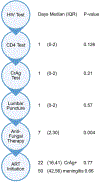Laboratory-Reflex Cryptococcal Antigen Screening Is Associated With a Survival Benefit in Tanzania
- PMID: 30422904
- PMCID: PMC6825442
- DOI: 10.1097/QAI.0000000000001899
Laboratory-Reflex Cryptococcal Antigen Screening Is Associated With a Survival Benefit in Tanzania
Abstract
Background: Cryptococcal antigen (CrAg) screening in persons with advanced HIV/AIDS is recommended to prevent death. Implementing CrAg screening only in outpatients may underestimate the true CrAg prevalence and decrease its potential impact. Our previous 12-month survival/retention in CrAg-positive persons not treated with fluconazole was 0%.
Methods: HIV testing was offered to all antiretroviral therapy-naive outpatients and hospitalized patients in Ifakara, Tanzania, followed by laboratory-reflex CrAg screening for CD4 <150 cells/μL. CrAg-positive individuals were offered lumbar punctures, and antifungals were tailored to the presence/absence of meningitis. We assessed the impact on survival and retention-in-care using multivariate Cox-regression models.
Results: We screened 560 individuals for CrAg. The median CD4 count was 61 cells/μL (interquartile range 26-103). CrAg prevalence was 6.1% (34/560) among individuals with CD4 ≤150 and 7.5% among ≤100 cells/μL. CrAg prevalence was 2.3-fold higher among hospitalized participants than in outpatients (12% vs 5.3%, P = 0.02). We performed lumbar punctures in 94% (32/34), and 31% (10/34) had cryptococcal meningitis. Mortality did not differ significantly between treated CrAg-positive without meningitis and CrAg-negative individuals (7.3 vs 5.4 deaths per 100 person-years, respectively, P = 0.25). Independent predictors of 6-month death/lost to follow-up were low CD4, cryptococcal meningitis (adjusted hazard ratio 2.76, 95% confidence interval: 1.31 to 5.82), and no antiretroviral therapy initiation (adjusted hazard ratio 3.12, 95% confidence interval: 2.16 to 4.50).
Conclusions: Implementing laboratory-reflex CrAg screening among outpatients and hospitalized individuals resulted in a rapid detection of cryptococcosis and a survival benefit. These results provide a model of a feasible, effective, and scalable CrAg screening and treatment strategy integrated into routine care in sub-Saharan Africa.
Figures



References
-
- World Health Organization. Rapid advice: Diagnosis, prevention and management of cryptococcal disease in HIV-infected adults, adolescents and children. Available at: www.who.int/hiv/pub/cryptococcal_disease2011. Accessed 1 Jan 2017. - PubMed
Publication types
MeSH terms
Substances
Grants and funding
LinkOut - more resources
Full Text Sources
Medical
Research Materials

